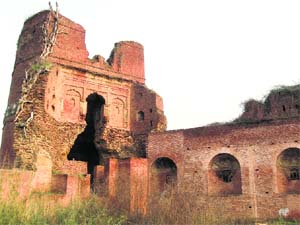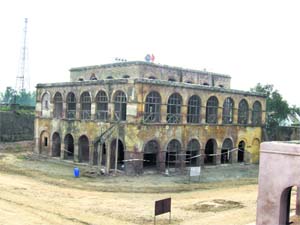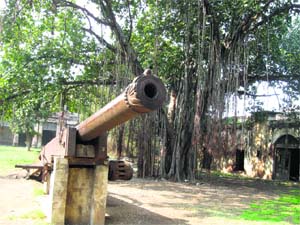Forlorn fortifications
Weather-beaten citadels and moat-girded forts in Punjab, unkempt and neglected, are visible reminders of the state’s heritagePuneetinder Kaur Sidhu
THE fact that undivided Punjab was well-located on the inroad to Hindustan left many an invader chuffed. Rulers at the receiving end began building citadels of varying sizes and strategic needs. The landscape was studded with impregnable edifices whence the potentate in residence defended his moat-girded abode from behind ramparts and lofty barbicans. Over time, with the advent of modern warfare, they were rendered obsolete. The decadence of Mughal rule found some of them falling into colonial hands — ones that housed military barracks and training academies, unmindful of destruction of heritage. Post-Independence, they simply changed hands while maintaining status quo. Those in possession of owning nobility fell quickly into disrepair with the abolishing of the Privy Purse in 1971. Ruination was just a matter of time. One ancient fortification survives in Bathinda. Harking back to the early Christian era, its name is a derivative of Bhatti, a reference to the Rajput clan that lorded over it some 1200 years ago. Thirteenth- century historians talk about one Tabarhind governed by Altunia; notorious for his revolt against Razia Sultan, then the Empress of Hindustan, whose charge against him resulted in her incarceration in this fort. Following her thwarted attempt at escape, she joined forces with her captor, marrying him even, to re-capture Delhi. They were defeated and killed and the rest, they say, is celluloid history. Mid-eighteenth century, the fort fell into the hands of Baba Ala Singh of Patiala and thereon followed the history of the former principality. Renamed Gobindgarh after the tenth Sikh Guru, a gurdwara high on the ramparts marks his reputed visit. Resembling a big old clipper of expansive girth, it rises Phoenix-like from the heart of Bathinda, its architectural design pointing to a past as a military, non-residential fortification. The Rani Mahal above the towering entrance is evidently a later addition. Other than the walking paths around well-tended lawns and the gurdwara, the rest of the fort is exempt from public viewing. The pavilion-topped bastion has an incredibly beautiful ceiling. The Qila Mubarak in Faridkot is reportedly of similar chronology, though its early history remains obscure. While what we see today is in some disrepair, with several additions by subsequent rulers, it is one of few family-held forts still surviving. Its multi-tiered entrance, barred by a mammoth wooden gate, is crowned by the Sheesh Mahal sprawled across an entire floor. The Durbar Hall — an architectural marvel, it is said to remain cool even during Punjab’s sweltering summer — is kitted out with an intricately decorated plaster-of-Paris-and-woodwork ceiling. This fort is temporarily out of bounds for public, till such time its ownership is re-established. A wait of some two decades has recently found two former princesses on the triumphant side of familial litigation. The fort built by the Nawabs of Malerkotla, never a large edifice to start with, is today merely a sad cluster of crumbly walls and rubble mounds. The curiously circular building, with obvious European influences, once housed the royal courts. None can shy away from the faded majesty that manifests in the intricate embellishments still visible on their facades. Yet another weather-beaten citadel stoically sits on the outskirts of Hoshiarpur. The Bajwara fort looks anything but a fort. Two multi-tiered bastions sporting towering arched portals connect an impenetrably thick wall, the roofs have caved in and a persistent peepal has been victorious in rooting itself into the outer wall of one of its bastions. Yet it holds ground, a silent and telling sentinel to history. Little is known of its origin. Some believe it was built by Afghans from Ghazni; others that Baiju Bawra, the renowned dhrupad singer, lent it his name. British gazetteers state its use as a prison for mutineers of 1857 and locals say it was built by Sher Shah Suri. Other forts of significance are reminiscent of the Sikh Empire and the times just preceding. The confident rise of Sikh confederacies saw those establishing garhis (mud forts) in territories owned, usurped and annexed by them, with the prominent Phulkians marking their presence in Patiala, Nabha and Jind (Haryana). The massive Nabha fort in the centre of town has housed government departments and is a pale shadow of its former self. Qila Androon in Patiala is a fine testimony to Mughal and Rajasthani styles of architecture. It houses an elaborately frescoed Sheesh Mahal, sundry palaces and courtyards within its confines — all out-of-viewing bounds. Other than the Darbar Hall-cum-museum, visitors only get to see the forlorn remnants of the Sarad Khana meant for European guests, the ionic-columned Jalau Khana or exhibition hall, and a couple of cannon barrels. On Patiala’s periphery stands another fort, in reasonable mint condition, largely due to the presence of the Punjab Police Commando Training School located within. Built by Nawab Saif Khan in Aurangzeb’s rule, it was called Saifabad; renamed Bahadurgarh to commemorate the stay here of Guru Tegh Bahadur. A gurdwara allows limited acess. Associated with Maharaja Ranjit Singh, the colossal Gobindgarh fort in Amritsar is distinct for its military architecture. Formerly owned by the Bhangi clan, it was later commandeered by the Maharaja. Its tosha khana hosted his treasury, including the matchless Kohinoor at one point. Long possessed by the Army, it is currently undergoing a massive restoration exercise, and is slated to throw open its doors to the public in a year’s time. Another at Phillaur was a Mughal serai before Ranjit Singh gave it a fortified makeover. Following the defeat of Sikh forces, it was occupied by the British army before it was converted into a police training centre in 1890. It continues to be one, and bears the Maharaja’s name, even though it boasts of just one surviving structure from his times. |
From : The Tribune , Sunday, June 15, 2014



